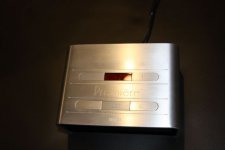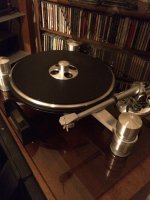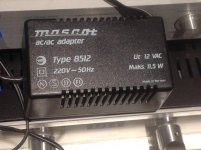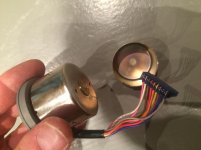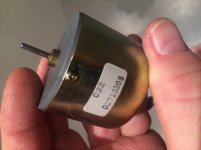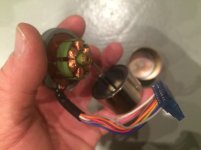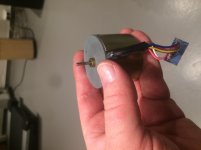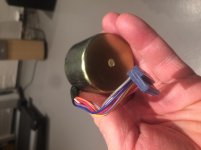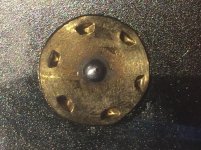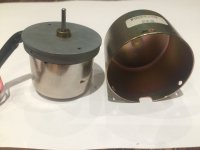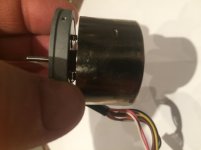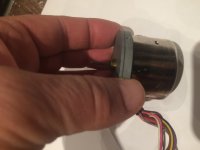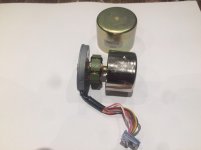my MK III - 27 VDC motor driver board is completely different and uses 14 pin transistor array chips to drive the motor, (CA3096 if I recall). The board isn't potted and I changed the 5 % resistors to 1% and several of the 0.47 to 3 .3 uf tantalum coupling caps to Wima polyesters for longer life and stability. i added a 220uf/35 volt cap inside the motor housing for input decoupling and local storage - oddly Oracle had no local supply cap near the motor and sold the overpriced external cap stabilizer unit as an upgrade.
The newer Turbo 27 VDC power supply is an AC input EMI filter feeding one of the blue Indian low cost torroids from Digikey. a regular 4 pin bridge rectifier feeding 2 stage RC filter then an IR fet with a zener to it's base set up as what looks to be a shunt regulator. As a $1,000 upgrade it's a little short on value. You could easily DIY it better for $100 - $150. with FAST/SOFT recovery diodes, a C core or dual bobbin transformer, 105C caps etc..
The newer Turbo 27 VDC power supply is an AC input EMI filter feeding one of the blue Indian low cost torroids from Digikey. a regular 4 pin bridge rectifier feeding 2 stage RC filter then an IR fet with a zener to it's base set up as what looks to be a shunt regulator. As a $1,000 upgrade it's a little short on value. You could easily DIY it better for $100 - $150. with FAST/SOFT recovery diodes, a C core or dual bobbin transformer, 105C caps etc..
RTFM RTFM!!
Well I be jiggered!
I just read the MKIII manual from front to back as I am getting ready to align the suspension and found a detail I missed...and for the last many years of ownership of this table, had no idea.....
THERE IS A PITCH CONTROL POT ON THE SIDE OF THE SPEED SELECTOR SWITCH HOUSING!
 Jeeeeez.
Jeeeeez.
I will dismantle the housing and get some Cramolin on the pot and switches and that should be the last maintenance this table needs for a while.
Just thought you might like to know.
Cheers
Well I be jiggered!
I just read the MKIII manual from front to back as I am getting ready to align the suspension and found a detail I missed...and for the last many years of ownership of this table, had no idea.....
THERE IS A PITCH CONTROL POT ON THE SIDE OF THE SPEED SELECTOR SWITCH HOUSING!
 Jeeeeez.
Jeeeeez.I will dismantle the housing and get some Cramolin on the pot and switches and that should be the last maintenance this table needs for a while.
Just thought you might like to know.
Cheers
possible arms for Oracles....
The obvious choice would be the Oracle/SME 345 if you can get one, else a SME 309, IV or V (345= arm wand/headshell from 3XX arm, bearings from the IV, and internal wiring from a V).
It really depends on the cartridge being used, but a hot-rodded RB300 with a DL103 or better could be a consideration, or an AT-440ML. My personal faves are Grado, and I have had great success with the old 8MR on my Alex MkII.
But as per your list:
1. Fidelity Research FR-64fx: Apparently excellent, particularly with moving coils.
2. SME 3009 Series II: has always been well reviewed (I owned one for a time, particularly finicky to set up). I had the 3009 III (with damping trough) which is what makes this a no-brainer for almost any cartridge, whether MM or MC
3. Audio Technica AT-1005MKII:dubious at best, based on reviews
4. Rega RB300: If hot-rodded a fine arm. I did one of these and it sounded good using an old Ortofon 3 Turbo, the owner has a DL103R mounted on it now (on a Roksan Xerxes MkI) and is thrilled with it.
5. Syntec S-220: Suggested for high compliance cartridges only.
If it were me, I would hot-rod a RB-300 (upgrade internal cable, upgrade counter-weight/end-stub, add a VTA adjustment scheme) or consider sending it away to one of the well known tweekers (or just ordering an Audiomods kit for it).
I have 5 different arms to potentially use, and I welcome any input from others who have had experience with any of these arms. I also have a variety of cartridges to match with the various arms...but that is a new thread.
1. Fidelity Research FR-64fx
2. SME 3009 Series II
3. Audio Technica AT-1005MKII
4. Rega RB300 (currently on it)
5. Syntec S-220
Your thoughts? What would be the best bet for this table? I know it's a tough question, and maybe there is no one correct answer.
Paul
The obvious choice would be the Oracle/SME 345 if you can get one, else a SME 309, IV or V (345= arm wand/headshell from 3XX arm, bearings from the IV, and internal wiring from a V).
It really depends on the cartridge being used, but a hot-rodded RB300 with a DL103 or better could be a consideration, or an AT-440ML. My personal faves are Grado, and I have had great success with the old 8MR on my Alex MkII.
But as per your list:
1. Fidelity Research FR-64fx: Apparently excellent, particularly with moving coils.
2. SME 3009 Series II: has always been well reviewed (I owned one for a time, particularly finicky to set up). I had the 3009 III (with damping trough) which is what makes this a no-brainer for almost any cartridge, whether MM or MC
3. Audio Technica AT-1005MKII:dubious at best, based on reviews
4. Rega RB300: If hot-rodded a fine arm. I did one of these and it sounded good using an old Ortofon 3 Turbo, the owner has a DL103R mounted on it now (on a Roksan Xerxes MkI) and is thrilled with it.
5. Syntec S-220: Suggested for high compliance cartridges only.
If it were me, I would hot-rod a RB-300 (upgrade internal cable, upgrade counter-weight/end-stub, add a VTA adjustment scheme) or consider sending it away to one of the well known tweekers (or just ordering an Audiomods kit for it).
Oracle Premiere MKII Speed Creep
Just found this thread in my search to better understand how to resolve the speed fluctuations with my Oracle Premiere TT. I've just purchased the table a few months back and its paired with a Wilson-Benesch ACT 0.5 tonearm (purchased separately) and Van den Hul MC10 cartridge and Jasmine Phono Stage. After spending some time dealing issues w/ a missing armboard mount (long story), and tonearm setup, I'm very pleased with the sound quality. I was pretty happy with my Alexandria and DL160 combo, but always loved the Delphi series, and was fortunate to find this Premiere after several months of hunting on eBay and the major Audio classified websites.
Is anyone familiar with the motor and external control unit for this model? I've had to adjust the 33.3 pot several times now as the speed tends to increase, which I start to notice by hearing less bass and some harshness in the high frequencies.
Thanks!
Just found this thread in my search to better understand how to resolve the speed fluctuations with my Oracle Premiere TT. I've just purchased the table a few months back and its paired with a Wilson-Benesch ACT 0.5 tonearm (purchased separately) and Van den Hul MC10 cartridge and Jasmine Phono Stage. After spending some time dealing issues w/ a missing armboard mount (long story), and tonearm setup, I'm very pleased with the sound quality. I was pretty happy with my Alexandria and DL160 combo, but always loved the Delphi series, and was fortunate to find this Premiere after several months of hunting on eBay and the major Audio classified websites.
Is anyone familiar with the motor and external control unit for this model? I've had to adjust the 33.3 pot several times now as the speed tends to increase, which I start to notice by hearing less bass and some harshness in the high frequencies.
Thanks!
Attachments
Argh. Speed issue has raised its ugly head. Will have to dig in.
Lights on the front control panel get brighter (than normal) and dimmer as the speed goes up and down, so I'm guessing it's not as simple as replacing the AC transformer (which someone else had already done).
Expect I should cleanup the motor (if it is periodically binding a bit, that could explain it).
But I'm just blowing smoke until I open it up (at which time, I hope I'm not
blowing any smoke). Wish me luck. Suggestions welcome.
Lights on the front control panel get brighter (than normal) and dimmer as the speed goes up and down, so I'm guessing it's not as simple as replacing the AC transformer (which someone else had already done).
Expect I should cleanup the motor (if it is periodically binding a bit, that could explain it).
But I'm just blowing smoke until I open it up (at which time, I hope I'm not
blowing any smoke). Wish me luck. Suggestions welcome.
Ticknpop asked why a 12VAC supply rather than a 27VDC like he has on his MKIII. Very good question. I found several posts and pics indicating that the original was a 12VAC 1.0A supply.
Here is a picture I found for a MKIII, according to the ad.
So who out there has a MKIII, and what is your external PS rated at? Any pics?
Also, has anyone found schematics for the epoxy module under the motor? I am about to tear into mine and thought it would be good to know what I am getting into beforehand.
Cheers
My Delphi III has a 220V 50Hz Mascot Type 8512 with 12VAC max 11.5W out. See attached picture. The Norwegian representative at the time probably sourced this directly from Mascot here in Norway.
Rolv-Karsten
Attachments
I opened up my motor to look for problems. It seems ok. Here are a few pictures.
It seems the "bell" to the left rotates, and that the center part of the bottom to some degree rests on that white central "dot" of the right part. Is that Delrin or something? There is also some grease on it, and this grease seems ok and enough as well.
motor noises...
Hi guys.
Wow, that's a very different motor than I have on my Alex MkII. So here's what I would do if I had a motor like that. Firstly, make sure when the rear "can" is put back on the motor, I would endure that it doesn't touch the back plate of the motor.
I would use an "electrical" grease and grease the bushings where the shaft runs through the end plates.. Run the motor without being installed continuously for a few days. Then reinstall it. Use a stethoscope to hunt down the noise if any still. You could also get a rubber band and wrap it around the motor can to reduce standing waves in the metal of the can (used when a mechanic puts car rotors on a brake lathe so that standing waves don't set up inside the rotor and create stress cracks).
Hi guys.
Wow, that's a very different motor than I have on my Alex MkII. So here's what I would do if I had a motor like that. Firstly, make sure when the rear "can" is put back on the motor, I would endure that it doesn't touch the back plate of the motor.
I would use an "electrical" grease and grease the bushings where the shaft runs through the end plates.. Run the motor without being installed continuously for a few days. Then reinstall it. Use a stethoscope to hunt down the noise if any still. You could also get a rubber band and wrap it around the motor can to reduce standing waves in the metal of the can (used when a mechanic puts car rotors on a brake lathe so that standing waves don't set up inside the rotor and create stress cracks).
Hi Nanook
I do not know the brand of this motor. (Any idea?) But it is installed inside some plumbers plastic tube, cut in the length of the motor. Between the motor and the tube there is a layer of a rubber material, maybe 1 - 2 mm thick. I can measure that and also take some more images.
It seems this outer can touches the rotating part, via a small piece of maybe Delrin (?) with some grease. I am really not certain whether it shall touch or not....
Seems at least the shaft is oiled where it runs out at the top, e.g. close to the pulley.
When I run the motor now "out in the open" I can feel small vibrations. But nothing like the noise I hear when the belt and platter is installed. I shall do some more checking, and change the oil in the platter bearing. It looks OK though.
It is by the way possible to move the shaft a little up and down, but basically it seems located without touching the outer can, as you wrote.
/RK
I do not know the brand of this motor. (Any idea?) But it is installed inside some plumbers plastic tube, cut in the length of the motor. Between the motor and the tube there is a layer of a rubber material, maybe 1 - 2 mm thick. I can measure that and also take some more images.
It seems this outer can touches the rotating part, via a small piece of maybe Delrin (?) with some grease. I am really not certain whether it shall touch or not....
Seems at least the shaft is oiled where it runs out at the top, e.g. close to the pulley.
When I run the motor now "out in the open" I can feel small vibrations. But nothing like the noise I hear when the belt and platter is installed. I shall do some more checking, and change the oil in the platter bearing. It looks OK though.
It is by the way possible to move the shaft a little up and down, but basically it seems located without touching the outer can, as you wrote.
/RK
Here are two images more. One shows again the opened motor with the can to the right in that picture. You will see the little central piece of plastic (Delrin?) with grease on.The other picture shows the lower piece of the rotating part (motor) with some kind of ball resting on the piece of Delrin.
Could the grease on the Delrin (plastic) part be Lithium grease?
Could the grease on the Delrin (plastic) part be Lithium grease?
Attachments
Last edited:
By two of these images I am trying to show the rotating part being held in place by magnetic force, however it is possible to press it further in. This means that with the shaft pointing upwards as in normal use, the rotating parts (windings et al), by gravity "falls" down to the can. It is probably as it should be(?), because when collected together the ball makes contact to the Delrin part of the can.
Attachments
- Status
- This old topic is closed. If you want to reopen this topic, contact a moderator using the "Report Post" button.
- Home
- Source & Line
- Analogue Source
- Oracle Delphi MK III speed issues...help
